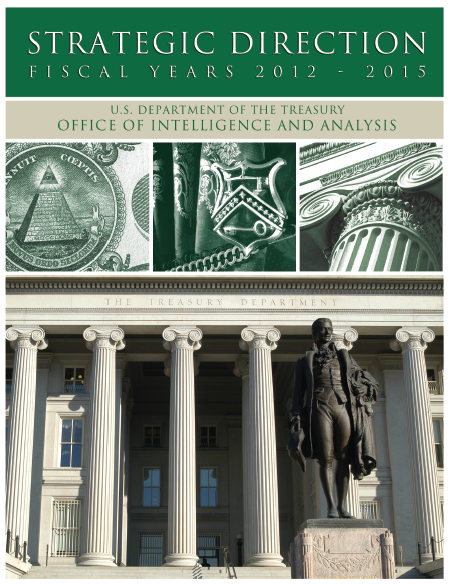Office of Intelligence and Analysis (OIA) Strategic Direction 2012-2015
- 21 pages
- August 13, 2012
- 6 MB
Intelligence has played an important role in the exercise of the responsibilities and operations of the Treasury Department since the Department assumed its enforcement responsibilities in 1789. The mission and culture of Treasury’s Office of Intelligence and Analysis builds on this strong tradition of intelligence and national security at the Department.
Intelligence at the Treasury
The Department of the Treasury’s earliest intelligence efforts were exclusively focused on law enforcement with the establishment of criminal intelligence functions within the U.S. Coast Guard and the Internal Revenue Service, which sought to collect and analyze information in support of Treasury’s domestic law enforcement functions. In 1961, the Department established its first foreign intelligence capability, the Office of National Security (ONS), which was charged by Treasury Secretary Douglas Dillon to connect the Treasury Department with the broader efforts of the National Security Council. In 1977, ONS was overhauled and renamed the Office of Intelligence Support (OIS) by Treasury Secretary Michael Blumenthal and Treasury’s place in the U.S. Intelligence Community (IC) formalized on December 4th 1981, under Executive Order 12333, United States Intelligence Activities, by President Ronald Reagan. Finally, in late 2003, Treasury’s intelligence mission and needs were recognized in the Intelligence Authorization Act of 2004 (31 U.S.C. sec. 312), which established OIA.
…
OIA Activities
Strategic Analysis
OIA’s intelligence analysis has been critical to Treasury efforts to stem the flow of funding to terrorist groups and disrupt weapons proliferation and other illicit networks around the world. Drawing on OIA’s analytic expertise, Treasury has designated multiple individuals and organizations for providing support to al-Qa’ida and other terrorist groups, for trafficking in narcotics, and for engaging in transnational criminal activity. OIA actively supports Treasury’s role in pressuring Iran, which includes bilateral, multilateral, and U.S. financial measures targeting the Iranian proliferation networks, the IRGC-Qods Force, and the Iranian financial and energy sectors. OIA also provides expertise and analytical support to inform Treasury efforts to disrupt North Korean proliferation and regime finance networks, Syrian government abuse of human rights, Mexican transnational criminal networks, and to target financial institutions that threaten the U.S. financial system.
Tactical and Operational Analysis and Support to the Warfighter
Over the years, OIA has developed sophisticated and comprehensive approaches to identifying and disrupting the funding networks underpinning national security threats, and OIA’s analytical expertise has enabled a wide range of U.S. and foreign government actions aimed at disrupting these networks. The Iraq and Afghanistan Threat Finance Cells (ITFC and ATFC, respectively) were established as joint intelligence, military, and law enforcement efforts to identify and disrupt the flow of funding to terrorist and insurgent networks in the war zones. Currently, OIA’s analytic leadership at the ATFC provides critical support to Treasury counterthreat finance programs, as well as law enforcement and military operations. OIA also actively supports law enforcement with intelligence analysis and lead generation, particularly with respect to Mexico and transnational organized crime. Finally, OIA’s work with the U.S. Special Operations Command (SOCOM) and other partners has resulted in enhanced threat finance lead-generation and information-sharing that have enabled U.S. and foreign government actions overseas.
Information-Sharing
In other intelligence disciplines, OIA has also made great strides. OIA regularly disseminates to the IC information with a unique perspective, often receiving positive feedback on its value to consumers. OIA also supports a robust information-sharing effort. Treasury Intelligence Online, OIA’s secure, on-line community of interest has over 5,000 users, growing by 66% from 2010 to 2011. Consistent with its responsibilities under E.O. 12333, OIA regularly collaborates with key foreign partners and is always looking for ways to better share critical information with those who can act on it.
Security
OIA’s security mission is to provide policy, strategic, and operational direction to the Department on issues relating to Treasury’s security functions and programs. These responsibilities are codified in 31 U.S.C. sec. 312, Executive Orders, Intelligence Community Directives, and other laws and regulations. This includes all aspects of information and physical security, IT security oversight, personnel and industrial security, classification management, and Critical Infrastructure/Physical Security (CIPS) program management.
Counterintelligence
OIA has increased its focus on counterintelligence. The Office of Counterintelligence was created as part of OIA’s security element and is placing emphasis on counterintelligence awareness training, foreign travel and foreign contact reporting, insider threat, CI/Cyber, and Treasury-specific threat identification. Our counterintelligence professionals are also key contributors to IIRs released by OIA.
Facilitating Partnerships
A significant responsibility of OIA is to enable Treasury to meet its national security mission through the integration of the Department and the IC. Relationship-building, though, goes beyond sharing of information; recognition of compatible mission areas and complementary capabilities is key. For example, OIA has fostered the relationship between the Department’s Office of Critical Infrastructure Protection and Compliance Policy and information assurance elements within the IC. Treasury is the financial sector lead for critical infrastructure protection and relies on interagency partners to provide information on risks and vulnerabilities of the domestic financial sector, and OIA works to ensure open channels of communication and mutual understanding between our Departmental and IC colleagues.
…



